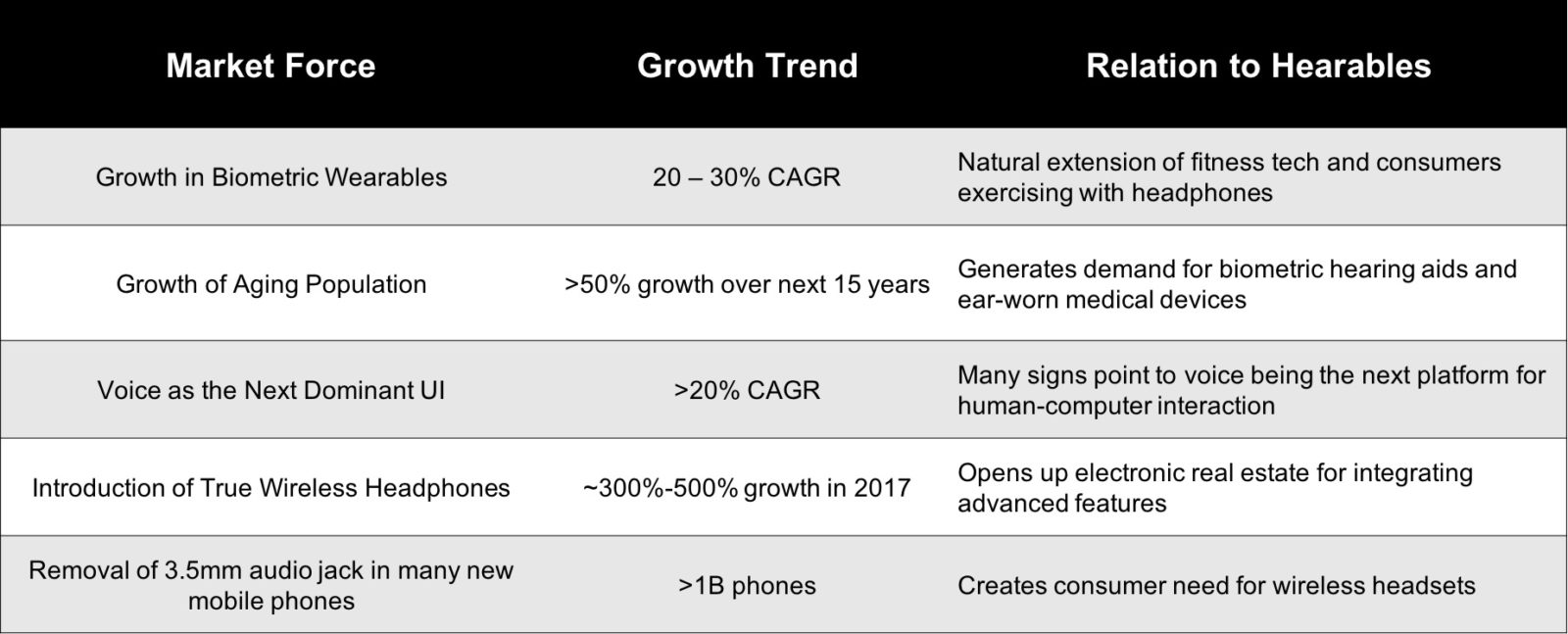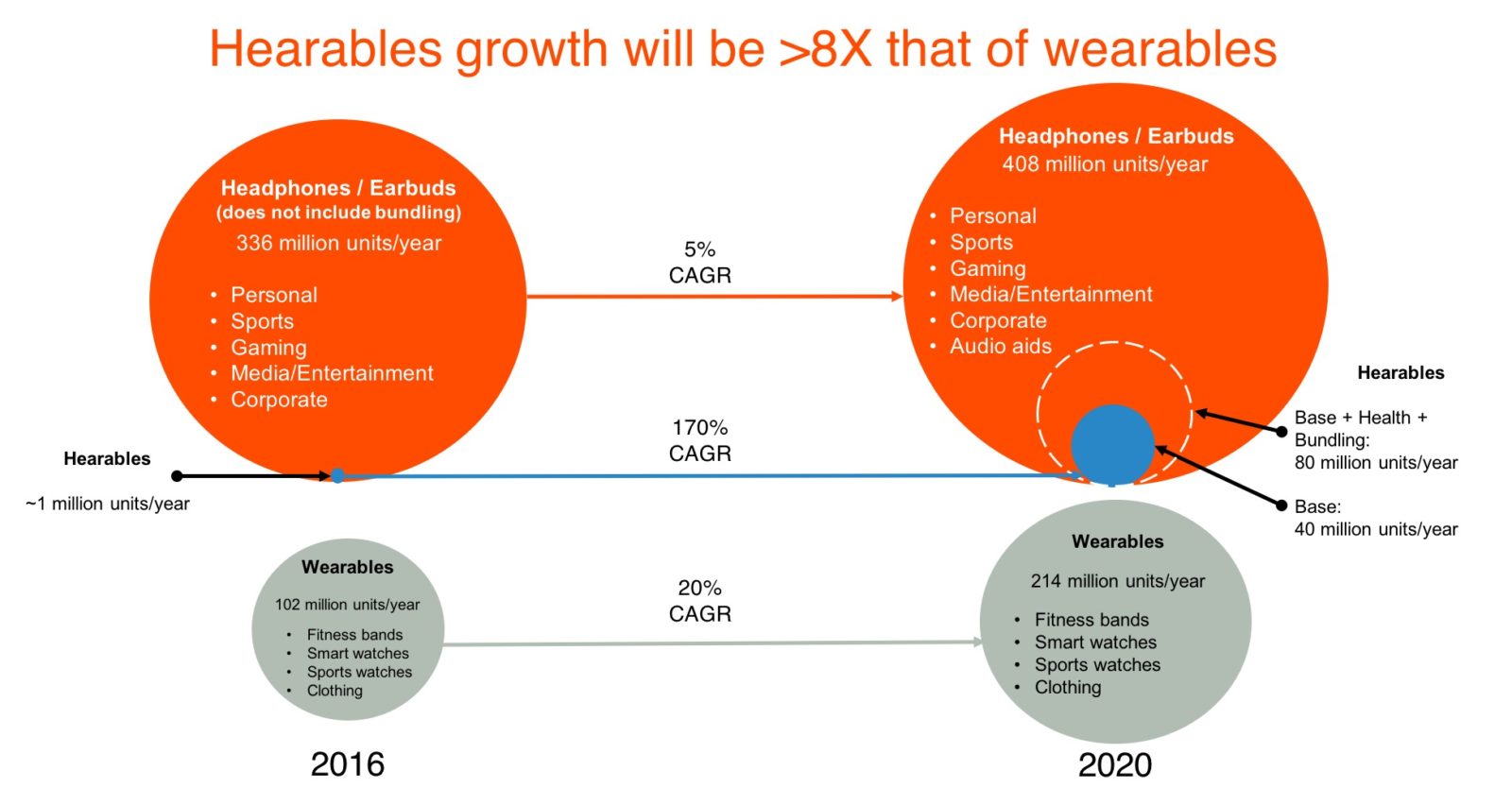What’s Driving Hearables Growth?
The hearables market is benefitting from the growth in voice user interface (UI) and resulting customer expectations. There are several other factors driving growth in the hearables market, which has the potential for growth rates far beyond the wearables market.

Existing Real Estate
What many people don’t realize is that hundreds of millions of headphones are sold every year, not including those bundled with mobile phones.
This provides significant “existing real estate” that can be upgraded to hearable devices in standard product upgrade cycles. This is very different from the wearables market, which is creating a new category, new products and new adoption cycles.

Removal of 3.5mm jack from mobile phones
The removal of the 3.5mm audio jack from major mobile phones, particularly Apple and Samsung, is drove growth in wireless (Bluetooth) earbuds. The number of wireless earbuds sold has exponentially grown year over year. This has driven up the average retail price of earbuds, which drives up customer expectations for the capabilities of the devices and gives manufacturers more margin to add new features to meet those higher customer expectations.
New Capabilities Turning Headphones into Hearables
The addition of new capabilities is creating a new category of devices that go beyond simple audio that has come to be called Hearables. Some of the more popular new capabilities included in these devices are:
- Biometrics – you can now measure heart rate and other biometrics with many new hearables on the market today, including products from Sony, Samsung, Bose, Jabra, and many others.
- Sound isolation/augmentation – hearing augmentation is no longer just for the hard of hearing. New innovations in sound isolation and augmentation are driving new products to market with the ability to tune out sound you don’t want to hear and focus on those you do. For example, these devices can turn down ambient sound from a noisy coffee shop and focus on the voice of the person across the table from you. A few examples here include Nuheara IQBuds and Doppler Labs Here One.
- Voice UX – it’s fair to say the growth in voice as a user interface is a big factor in the growth and interest in hearables today.
- Passthrough – headphones have the tendency to isolate the user from their surroundings, particularly the over-the-ear headphones with active noise cancellation. This is highly desired in some cases, but Hearables makers have also recognized the need for users to be able to hear what’s going on around them. You are seeing new hearables come to market with the ability to “passthrough” surrounding sound to mimic hearing as if the user was not wearing anything in their ears.
True Wireless
There is a significant amount of development going on around the concept of a “true wireless” headset, in which the earbuds are completely disconnected and communicate wirelessly with each other and with a mobile device. Consumers are starting to recognize the revolutionary experience that true wireless earbuds can deliver.
This has spawned a sub-segment of the hearables market that are now true wireless, including products from Bragi, Jabra, Earin, Doppler Labs, Kanoa and many more.
Aging population
With populations in much of the world aging quickly [find verifiable stats on aging population], companies are aiming to deliver some of the new capabilities available in hearables to elderly people. This is driving new innovation in hearing aids and other medical devices to manage particular health conditions and disease states. For example, many hearing aid companies are evaluating adding biometrics, sound isolation, and voice UI into their future products. Additionally, medical device companies recognize the physiological superiority of the ear for measuring biometrics, which can support use cases including remote patient monitoring and disease management.
Challenges remain
It’s not all clear sailing for hearables. There are still challenges to overcome in order to hit mass market volumes and deliver outstanding customer experiences. Here are just a few:
- Battery life – small hearables means small batteries; major advancements are needed in this area
- Connectivity – particularly realiable Bluetooth
- Remove dependence on phone – which means advancements in cellular radios but also drains battery life
- Comfort – everyone’s ears are different and finding the right fit for a huge number of people can be challenging
- Social – some social awkwardness remains with headphones and earbuds, particularly with true wireless earbuds because sometimes people don’t notice them in your ears.
Valencell follows these market developments closely and will update periodically. If you are interested in discussing this further, please reach out to us at [email protected].